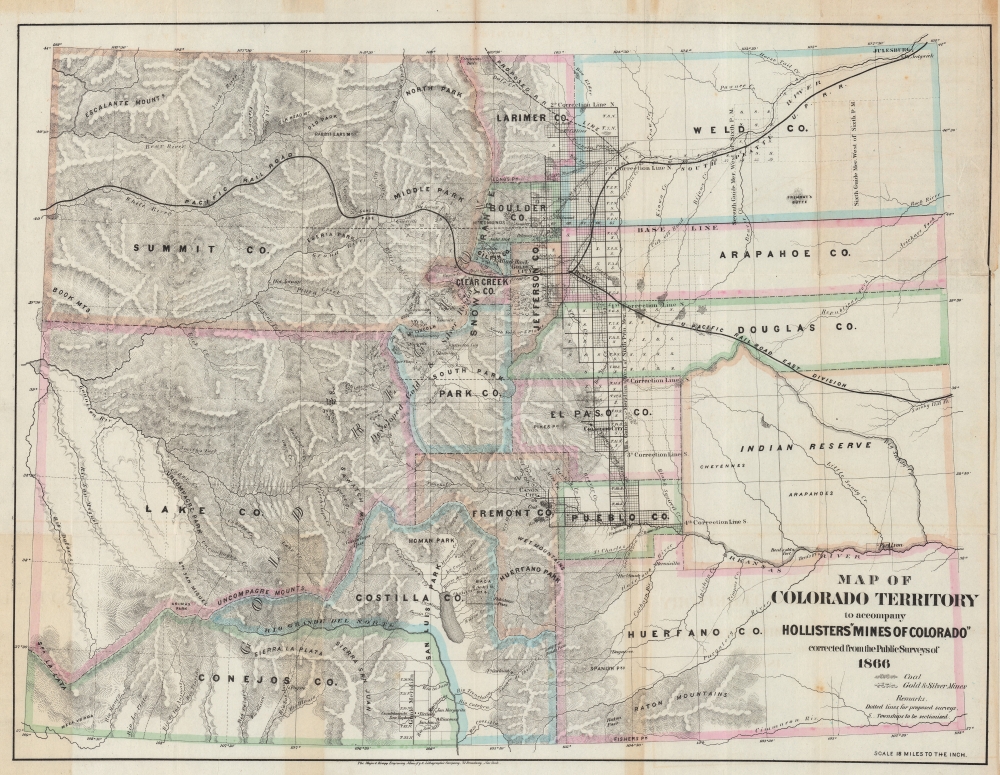This item has been sold, but you can get on the Waitlist to be notified if another example becomes available, or purchase a digital scan.
1866 Major and Knapp Map of the Colorado Territory
ColoradoTerritory-majorknapp-1867
Title
1867 (undated) 16.25 x 21.25 in (41.275 x 53.975 cm) 1 : 1140480
Description
A Closer Look
The nascent Public Land Survey township grid appears along the Front Range. Some townships have been divided into sections, while others, particularly those farther east, are projected. The grid reflects Colorado's growing appeal to settlers, particularly after astounding gold and silver discoveries. Some townships are marked in the mountains, but none have been sectioned. The same is true for the townships along the South Platte River. Counties are illustrated throughout with colored borders for differentiation. Denver, Golden City, Colorado City, Pueblo, and Cañon City, among other cities, are labeled.Publication History and Census
This map was created by Major and Knapp and published in Ovando Hollister's The Mines of Colorado in 1867. The separate map is cataloged at: Yale University, the Scottish Rite Masonic Museum and Library, the University of Michigan, the University of Kansas, Texas Tech University, the Denver Public Library, and Brigham Young University. The Mines of Colorado is well represented in institutional collections, however, due to the presence of microform editions in OCLC along with at least two reprintings, we are unable to determine how many actual example of the 1867 first edition survive.CartographerS
Richard C. Major (18?? - May 18, 1894) was a New York City and Brooklyn based American lithographer active in the second half of the 19th century. He likely apprenticed under his father Henry B. Major and Napoleon Sarony (1821 - 1896). In 1857, he became a partner in the firm of 'Sarony, Major and Knapp' (1857 - 1863), which from 1863 to 1888 operated as 'Major and Knapp.' In 1888, Richard retired, but in 1891 ran for 'Lithography Commissioner' at the 1891 Buffalo Pan-American Exposition. The 'Major and Knapp' firm was renamed Knapp and Company and operated under Joseph Fairchild Knapp (1832 - 1891) and his son, Joseph Palmer Knapp (1864 - 1951) from 56 Park Place, New York, until 1892. Like his partner, Major was also a major investor and director of the Metropolitan Life Insurance Company. When he died he left a fortune of 280,000 USD, about 10,000,000 USD in modern-day terms. More by this mapmaker...
Joseph Fairchild Knapp (July 1, 1832 - September 14, 1891) was an American printer and publisher active in the second half of the 19th century. From the age of 16, Knapp apprenticed as a lithographer under Napoleon Sarony (1821 - 1896) and Henry B. Major (18?? - 18??), at the firm of 'Sarony and Major.' Henry Major either died or left the firm around 1853, with, possibly, his shares being held in reserve for his son, who was then still an apprentice, Richard C. Major. In 1857, Sarony left the firm to travel and study in Europe, Knapp and Richard Major took over the firm, becoming partners, renaming the business 'Sarony, Major and Knapp' (1857 - 1863). It is unclear why Sarony's name was maintained, possibly to capitalize on his fame, as a honorific, or possibly because he owned a major stake. Nonetheless, in 1863, Sarony, who had been absent for 7 years, was pushed out of the company which was was renamed 'Major and Knapp.' They published under this imprint from various locations over the years: 449 Broadway (1864 - 1866), 71 Broadway (1867 - 1872), and 56 Park Place (1889 - 1892). Richard Major retired in 1888, and the firm was renamed Knapp and Company. The firm grew to become one of the largest lithographic presses in the United States and a major force in American printing. Knapp invested some of his considerable wealth into insurance concerns. In 1868, he was the largest shareholder and director, and chairman of the Metropolitan Insurance Company. He became president of the Metropolitan Insurance Company in 1871, pioneering the idea of the low-cost life insurance policy, propelling MIC to become one of the largest insurers in the United States. All the time, he also continued to operate and manage his printing business, which he passed on to this son Joseph Palmer Knapp (1864 - 1951). Palmer Knapp closed 'Knapp and Company' in 1982, a year after his father's death, to establish the American Lithographic Company, which consolidated various smaller printers under a new imprint. Knapp constructed a large and elegant mansion in Brooklyn, which stood at 554 Bedford Avenue. Learn More...

